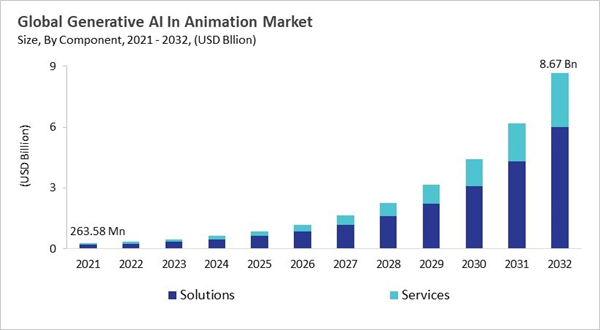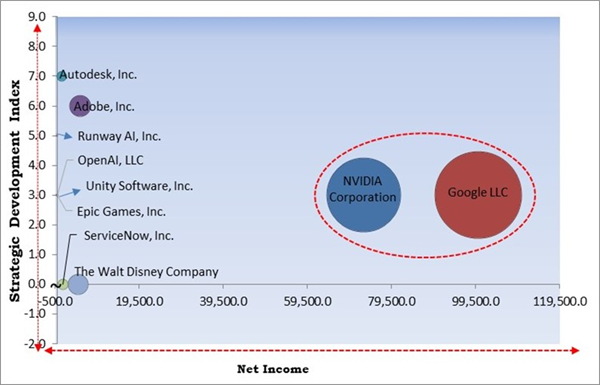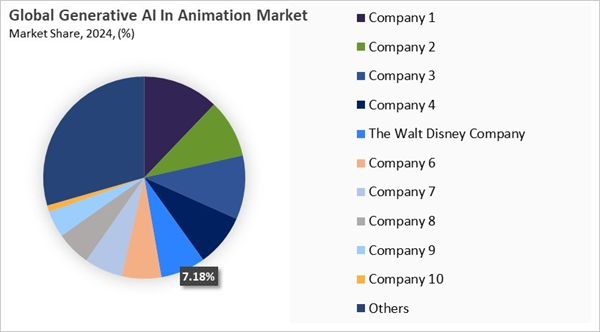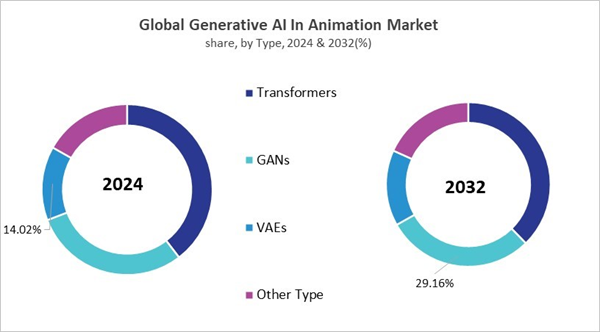Key Highlights:
- The North America market dominated Global Generative AI In Animation Market in 2024, accounting for a 33.00% revenue share in 2024.
- The U.S. market is projected to maintain its leadership in North America, reaching a market size of USD 2.01 billion by 2032.
- Among the various Component, the Solutions segment dominated the global market, contributing a revenue share of 72.19% in 2024.
- In terms of Type, Transformers segment are expected to lead the global market, with a projected revenue share of 37.67% by 2032.
- The Gaming market emerged as the leading End Use in 2024, capturing a 30.22% revenue share, and is projected to retain its dominance during the forecast period.
Generative AI has gained noticeable traction as a mainstream production engine along with animation workflows, transforming asset generation and story visualization, which was once limited to academic research. Organizations and governments are framing regulations aligning training data, rights management, and copyright, encouraging the adoption of lawful and auditable AI pipelines. OEMs such as NVIDIA, Autodesk, and Adobe are integrating AI into their platforms, allowing animators to block motion, retarget performances, storyboard, and speed up content localization. This transition enabled independent creators and studios to focus on design, iteration, and creative direction.
The industry adoption of generative AI in animation market is growing, driven by the standardization of interoperable 3D pipelines through initiatives like OpenUSD, the integration of AI-assisted performance through real-time prompt-to-motion, audio-to-facial systems, and the growth of creator-centric AI video generation platforms. Players like Runway prioritize speed of creation and innovation communities, even as labor and policy considerations assure human oversight, and credit remains central. Additionally, AI-driven tools enable creators to experiment with techniques and new styles, empowering content with a broader array of offerings. With the development of AI, it ensures the transformation in animation, thus supporting the expansion of generative AI in animation market.
The major strategies followed by the market participants are Product Launches as the key developmental strategy to keep pace with the changing demands of end users. For instance, In April, 2025, Adobe, Inc. unveiled Generative Extend in Premiere Pro, enabling editors to expand video and audio clips in 4K using Firefly AI. New features include AI-powered Media Intelligence, Caption Translation in 27 languages, and enhanced 3D tools in After Effects, and revolutionizing video editing workflows for professional creators and filmmakers worldwide. Additionally, In May, 2025, Epic Games, Inc. unveiled generative AI-powered NPCs in Fortnite, allowing users to create interactive characters with customizable voices, personalities, and dialogues. Integrated into Unreal Editor for Fortnite, the AI system includes tools like the Persona Device and Developer Assistant, enabling real-time conversations and enhanced developer support through AI-generated coding assistance.
Cardinal Matrix - Market Competition Analysis
Based on the Analysis presented in the Cardinal matrix; Google LLC, and NVIDIA Corporation are the forerunners in the Generative AI In Animation Market. In May, 2025, Google LLC unveiled Veo 3, a generative AI video tool that integrates audio, including dialogue and sound effects. Competing with OpenAI’s Sora, Veo 3 excels in realism and lip-syncing. Available via Google’s $249.99 Ultra plan, it targets AI enthusiasts and supports cinematic video creation through advanced prompting and editing features. Companies such as Adobe, Inc., The Walt Disney Company, and ServiceNow, Inc. are some of the key innovators in Generative AI In Animation Market.
COVID-19 Impact Analysis
The COVID-19 pandemic messed up the usual animation pipelines, but it sped up the use of generative AI as studios and creators looked for digital-first solutions. AI tools took care of things like lip-syncing, making backgrounds, and generating motion, which allowed smaller teams to keep up their work even when they didn't have a lot of resources. As streaming content became more popular, generative models sped up storyboarding, concept design, and scene rendering to make sure projects were delivered on time. Cloud-based AI platforms made it possible for teams that were spread out to work together in real time. This set a new standard for flexible production. Affordable AI solutions also made animation more accessible, letting independent artists and small studios make professional-quality content. This led to new storytelling formats and innovations during the crisis. Thus, the COVID-19 pandemic had a Positive impact on the market.Driving and Restraining Factors
Drivers
- Rising Demand for Realistic and Immersive Content
- Cost Efficiency and Faster Production Cycles
- Personalization and Content Diversity
- Technological Advancements in Generative Models and Tools
Restraints
- Intellectual Property and Copyright Concerns
- High Computational Costs and Infrastructure Limitations
- Resistance from Creative Professionals and Industry Skepticism
Opportunities
- Democratization of Animation Production for Independent Creators
- Hyper-Personalization of Content for Marketing and Entertainment
- Integration of Generative AI with Emerging Technologies (AR/VR/Metaverse)
Challenges
- Intellectual Property Rights and Copyright Issues
- Quality Control and Creative Authenticity
- Ethical Concerns and Workforce Displacement
Market Share Analysis
The leading players in the market are competing with diverse innovative offerings to remain competitive in the market. The above illustration shows the percentage of revenue shared by some of the leading companies in the market. The leading players of the market are adopting various strategies in order to cater demand coming from the different industries. The key developmental strategies in the market are Acquisitions, and Partnerships & Collaborations.
Type Outlook
Based on Type, the market is segmented into Transformers, GANs, VAEs, and Other Type. The GANs segment witnessed 29% revenue share in the market in 2024. This segment holds strong relevance in the market as Generative Adversarial Networks have been instrumental in producing realistic images, textures, and character designs that enhance the quality of animated content. GANs are particularly effective for style transfer, background creation, and enhancing visual fidelity, which are essential in both short-form and long-form animation projects.End Use Outlook
Based on End Use, the market is segmented into Gaming, Advertising, Movie Production, Televisions (Over-the-Top), and Other End Use. The Advertising segment witnessed 21% revenue share in the market in 2024. This segment has embraced generative AI as a means of creating personalized, visually appealing, and cost-effective animated content. Advertisers have utilized AI-driven animation for producing quick-turnaround campaigns, digital ads, and social media content that resonate with diverse audiences.Regional Outlook
Region-wise, the Generative AI In Animation Market is analyzed across North America, Europe, Asia Pacific, and LAMEA. The North America segment recorded 33% revenue share in the market in 2024. Generative AI in animation market is anticipated to have substantial growth in the North America and Europe regions. This growth is driven by regulatory frameworks, well-established creative industries, and technological leadership. The regional nations, like the US, are key hubs for AI researchers, software providers, and animation studios that are using generative tools in gaming, television, and production pipelines for film. Further, the region is also gaining traction due to a well-established startup ecosystem and investment in AI-based creative workflows. In addition, Europe is also experiencing expansion in generative AI in animation market. This is due to the wide acceptance of generative AI in gaming, advertising, and media. Also, the expansion is influenced by frameworks around rights management, cultural heritage preservation, and data governance.The Asia Pacific and LAMEA region are predicted to procure prominent growth in generative AI in animation market. The expansion is driven by evolving infrastructure and content production in nations like China, Japan, India, and South Korea. Regional studios are integrating generative AI for cost-efficient production, animation localization, along with government support, and surging acceptance of the digital economy. Moreover, the LAMEA region’s generative AI in animation market is growing because of the strong uptake in Latin America’s creative industries, including streaming and advertising content. The increasing investment in smart city initiatives and digital media in the Middle East region is resulting in growth opportunities. Further, the demand for affordable content creation tools in Africa is also rising, thereby expanding generative AI in animation market.
Market Competition and Attributes
Competition in the Generative AI in Animation market is highly fragmented and driven by startups, niche studios, and independent developers experimenting with AI-powered creative tools. Smaller firms compete through innovation, faster adoption of emerging technologies, and cost-effective solutions. Collaboration with animation studios, gaming companies, and streaming platforms further intensifies rivalry, as differentiation relies on creativity, efficiency, and scalability.
Recent Strategies Deployed in the Market
- Apr-2025: Adobe, Inc. unveiled an upgraded Firefly platform, integrating image, video, audio, and vector generation with advanced AI models, including tools from OpenAI and Google. Now generally available, Firefly offers powerful, commercially safe, production-ready creative tools for professionals, streamlining workflows across Adobe’s Creative Cloud ecosystem and enabling high-quality, collaborative content creation.
- Mar-2025: Runway AI, Inc. unveiled Gen-4, a high-fidelity AI video generator capable of creating consistent characters, scenes, and realistic motion using visual references and prompts. Backed by tech giants, Runway targets filmmakers and enterprises with advanced tools that simulate real-world physics, posing major implications for animation, film, and media production.
- Jan-2025: NVIDIA Corporation unveiled foundation AI models and NIM microservices for RTX AI PCs, enabling local generative AI workflows like digital humans, content creation, and productivity tools. Powered by RTX 50 Series GPUs, these tools help developers and enthusiasts build AI agents and creative workflows without relying on cloud infrastructure.
- Dec-2024: OpenAI, LLC unveiled Sora, its generative AI video tool that converts text prompts into short video clips. Available to paid ChatGPT users, it enables 720p and 1080p video creation, scene sequencing, and image animation. OpenAI emphasizes responsible use, adding watermarks and metadata to indicate AI-generated content.
- Sep-2024: Runway AI, Inc. announced the partnership with Lionsgate, an entertainment company to explore AI-generated video content, aiming to enhance pre- and post-production processes. This move may signal the rise of a new AI film genre, blending storytelling with generative technology, potentially transforming animation, filmmaking, and media production through AI-powered creativity and efficiency.
List of Key Companies Profiled
- Adobe, Inc.
- Autodesk, Inc.
- NVIDIA Corporation
- Google LLC
- The Walt Disney Company
- Unity Software, Inc.
- Epic Games, Inc.
- Runway AI, Inc.
- OpenAI, LLC
- ServiceNow, Inc.
Market Report Segmentation
By Component
- Solutions
- Services
By Type
- Transformers
- GANs
- VAEs
- Other Type
By End Use
- Gaming
- Advertising
- Movie Production
- Televisions (Over-the-Top)
- Other End Use
By Geography
- North America
- US
- Canada
- Mexico
- Rest of North America
- Europe
- Germany
- UK
- France
- Russia
- Spain
- Italy
- Rest of Europe
- Asia Pacific
- China
- Japan
- India
- South Korea
- Singapore
- Malaysia
- Rest of Asia Pacific
- LAMEA
- Brazil
- Argentina
- UAE
- Saudi Arabia
- South Africa
- Nigeria
- Rest of LAMEA
Table of Contents
Companies Mentioned
- Adobe, Inc.
- Autodesk, Inc.
- NVIDIA Corporation
- Google LLC
- The Walt Disney Company
- Unity Software, Inc.
- Epic Games, Inc.
- Runway AI, Inc.
- OpenAI, LLC
- ServiceNow, Inc.













